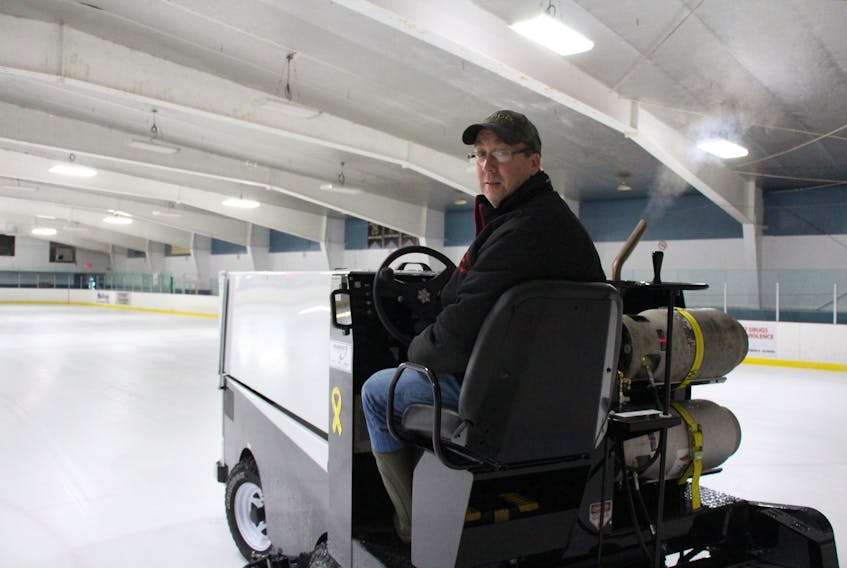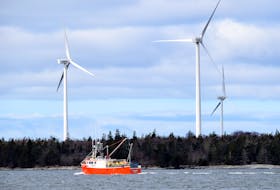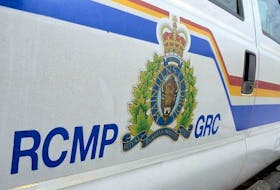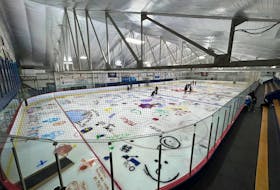TRENTON
It demands respect.
In the chain of authority, next to the ice plant, it sits at the top.
It has its own room in the back of the arena.
Its tires are sprayed down with water regularly and its propane tanks are rarely near the empty mark.
It dictates how the day is going to start and end in most arenas.
When the door slides up, people know that a new hockey game, public skate or figure skating show is about to begin.
People time their smoke breaks around it coming on and off the ice.
Hockey coaches redo lines and new defensive plays as it circles the ice surface.
Canteens are busier as patrons rush to get their coffee and fries during intermission.
Only a chosen few are allowed on the ice with it in order to move the hockey nets.
Children dream of driving it.
Adults mindlessly stare at it doing circle after circle until the ice is perfect.
A good flood goes unnoticed. A bad flood gets blamed for winning for losing hockey game.
It's technically an ice resurfacer, but to many, it is known by its brand name Zamboni, although there are other brand names.
Darryl Marcott, manager for the Trenton and Area Minor Sports Complex, has been sitting on top of the Zamboni ice resurfacer in Trenton for 26 years as of this April.
When he started, the ice resurfacer was a tractor with a tag-along that would scrape and water the ice surface, which was a step up from the barrels and hand scrapers used when the rink first opened in 1972.
“They used to do everything with ice scrapers,” he said. “They have a 2x8 puck board down along the boards and by the end of the season, the ice would be up over the top of the puck board in corners. You would have eight inches of ice, but now you have an inch and a half.”
Trenton received its first official Zamboni machine in 1999 with a price tag of $86,000. It was a bit smaller than the standard size to fit in the corners better, Marcott said. After 18 years of doing circles, it was replaced this November with a brand new one for $108,000.
Marcott said the machines are like cars: the more the bells and whistles, the more expensive they get. Trenton’s is a basic model but some come with back-up beeping, chrome wheels and tire washer systems.
All nice accessories, he said, but at the end of the day, it really comes down to the skill of the driver in terms of the job that is done.
It is definitely not a job for a nervous driver, he said. If you don’t like people watching you while you work, or backseat drivers, you might want to look at other career options.
“You think they are all looking at you. You aren’t saying they are but you think they are. Once you drive it for a while it is just like it is driving itself and you don’t even realize it.”
Ron Clarke, manager of the Hector Arena in Pictou, says he is always eyes-straight-ahead when he sits in the driver’s seat.
“I try not to look. I am looking at boards and glass. I don’t look out into the stands. I am straight ahead,” he said.
As a rookie in the ice resurfacing machine world, Clarke said he had very little experience when he took on the role of rink manager three years ago.
Only thing I drove close to that was a fairway cutter at the golf course. I guess you learn as you go,” he said. “Three-and-a-half years ago I didn’t know what a Zamboni (ice resurfacing machine) blade was. Now I know … and I know how to change it.”
Both Marcott and Clarke say they can be tricky to be drive because one side is blind to the driver.
“We cheat. We have a mark on the bow that you line up with where you need to be. One side is perfect to line up your wheel and the other side you line up the mark,” said Clarke.
Both men agree that next to the ice plant, it is their most expensive and most valuable piece of machinery because without it, a day’s worth of work would not get done.
SIDEBAR:
Just the facts
Facts about the Zamboni brand ice resurfacing machine:
• At approximately 1.2 kilometres per resurfacing, if there are four resurfacings per game, the machines travel an average of nearly five kilometres during each hockey game.
• On average, it “travels” close to 3,200 kilometres each year in the course of resurfacing.
• In 2001, a Zamboni ice resurfacing machine was driven from the East Coast of Canada (St. John’s, N.L.) across to the West Coast (Victoria, B.C.). At about 15 kilometres an hour, the journey took approximately four months.
• Over 10,000 machines have been delivered around the world.
• Frank Zamboni’s first patent (1,655,034) was for an adjustable electrical resister, which was awarded Jan. 3, 1928.
• The blade on the machine is designed especially for ice-resurfacing. It is sharp enough to slice through thick stacks of newsprint, weighs 26 kilograms (57 pounds) and is just over a centimetre thick.
In 2000, Frank J. Zamboni was inducted into the U.S. Figure Skating Hall of Fame. In 2006, Frank was inducted into the World Figure Skating Museum and Hall of Fame. In 2007, Frank was inducted into the National Inventors Hall of Fame. In 2009, he was inducted into the U.S. Hockey Hall of Fame.
In the early days, the inability of tires to get adequate traction on the ice was an issue. Before the introduction of tires implanted with steel studs in the mid 1960s, Frank Zamboni would have new tire casings re-treaded with a combination of rubber and crushed walnut shells. These re-treaded tires provided the best possible traction (without the use of chains, which would take their toll on the ice sheet) at the time, but not nearly as good as today’s studded tires.
“Not very scientific” facts and figures of one machine’s day:
Average number of resurfacings a day: 9.7
Time in operation per day (12 min per resurfacing): 116.40 minutes
Kilometres traveled per day – 11.7
Snow per resurfacing 1,700 litres or 60 cu. ft.
- Facts are provided by www. Zamboni.com









